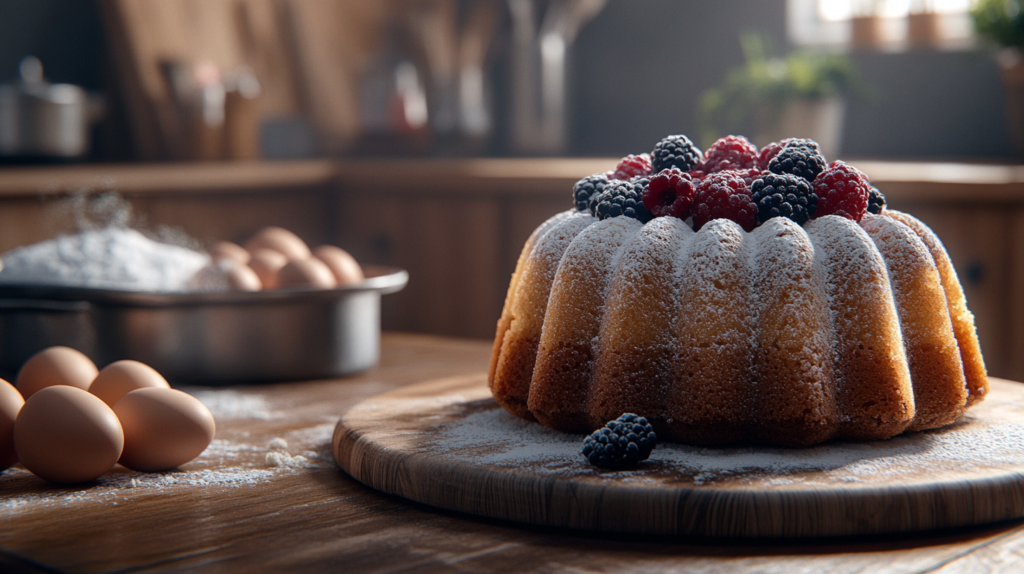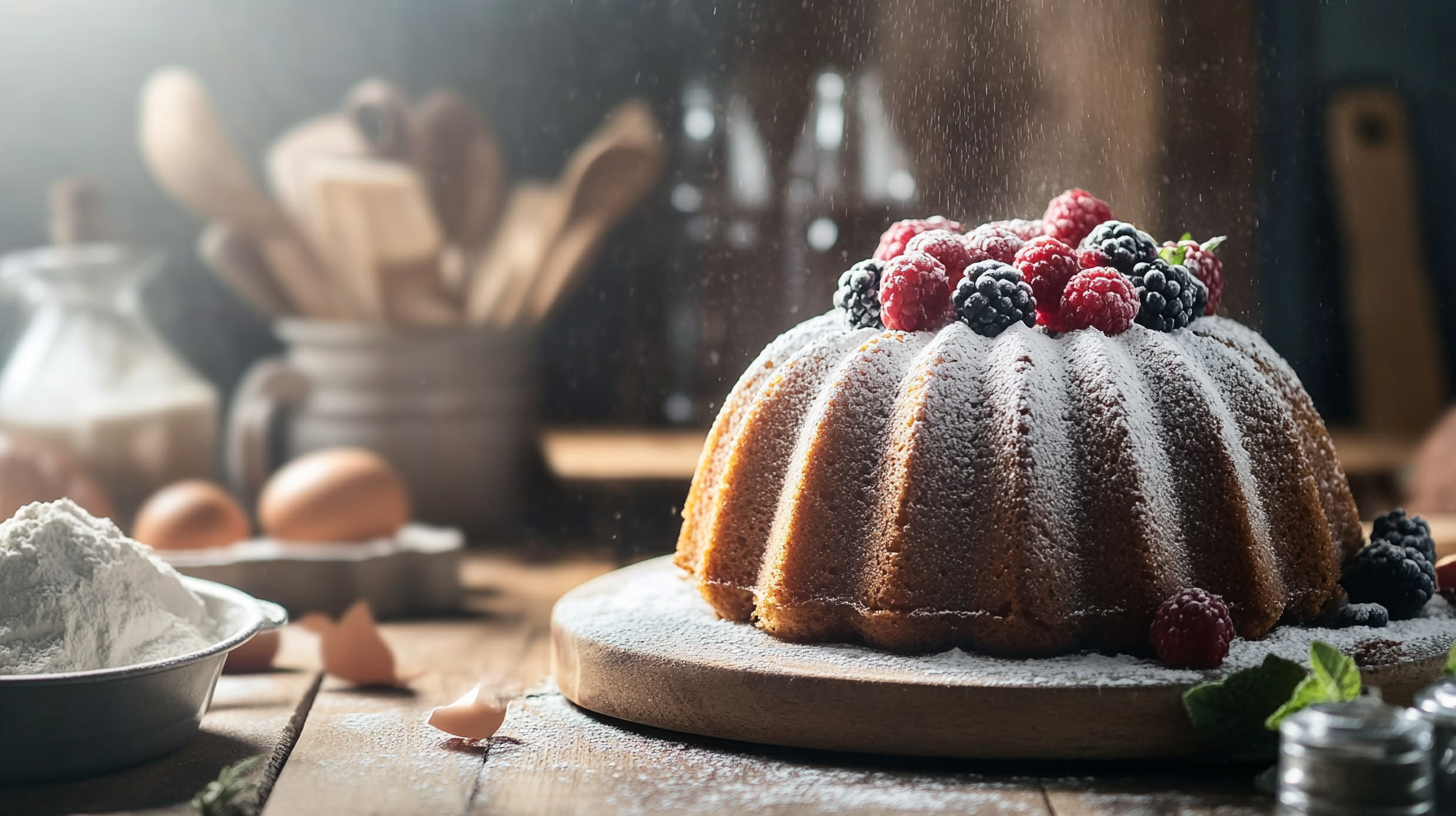Why Is It Called a Bundt Cake?
Bundt cakes have become a beloved dessert in both casual and formal gatherings. But have you ever wondered why they carry the name “Bundt”? Is there something special about it, or is it just a catchy title in the world of baking? In this article, we’ll explore the origins of the Bundt cake, the significance of its name, and how it became a staple in kitchens and bakeries. By the end, you’ll know why this cake is so special—and why it carries such a distinct name.
What Makes a Bundt Cake Special?
Before diving into the origin of the name, let’s first understand what makes Bundt cakes unique. While they seem fancy, Bundt cakes are really just cakes baked in a special pan. This pan gives the cake its signature round shape with a hole in the middle, allowing for even baking. The result? A cake that’s crispy on the outside but soft and moist on the inside.
Unlike other cakes, the Bundt cake’s shape plays a critical role. It allows for better heat distribution during baking, ensuring that the cake bakes evenly throughout. So, while the flavor of a Bundt cake can range from simple vanilla to more elaborate flavors like chocolate or lemon, the shape is what defines it.
The Key to the Bundt Cake’s Charm
At its core, a Bundt cake is a cake baked in a special pan with a hole in the center. But this pan isn’t just for show—it’s what makes the cake bake perfectly. The design ensures that the cake cooks evenly, with a crispy crust and a moist, flavorful interior.
Bundt cakes can be made in all sorts of flavors, from vanilla to chocolate to pumpkin. The shape makes them visually appealing, and they’re often served at parties, birthdays, and other celebrations. People love them for both their taste and their aesthetic charm.
The Popularity Surge of Bundt Cakes
Though Bundt cakes have been around for a while, they became widely popular in the 1960s. The cake skyrocketed to fame after Ella Helfrich entered a Bundt cake recipe into the Pillsbury Bake-Off. Her win helped launch the Bundt cake into the mainstream. Since then, it has become a household name, with people eager to try their hand at baking one themselves.
A Look Back: The History of Bundt Cakes
Now that you understand what makes a Bundt cake, let’s explore where it came from. The story of the Bundt cake goes way back in time, long before the 1960s. Let’s discover how this cake became so iconic.
European Origins: The Roots of the Bundt Cake
The Bundt cake has strong European roots, especially from Scandinavian and German traditions. The cake’s design originates from a German cake called the “Gugelhopf” or “Kugelhopf,” which dates back to the 18th century. This yeasted cake was traditionally baked in a ring-shaped pan with a hole in the middle, much like today’s Bundt pan.
In the 18th century, this type of cake was often baked for special occasions. The unique pan allowed the heat to circulate evenly, producing a cake with a golden crust and a soft, fluffy interior. Today’s Bundt cake pan is based on this same design, showing how baking traditions from centuries ago continue to influence modern desserts.
The Role of the Bundt Pan in Baking
What makes the Bundt cake pan so special is the way it allows for even heat distribution during baking. The central hole helps heat circulate, ensuring that the cake bakes evenly from the inside out. Without this pan, cakes would be more prone to burning on the outside while remaining raw in the center.
The Bundt pan also creates a signature shape—round with a central hole—that not only ensures an even bake but also adds a dramatic visual appeal. It’s a simple design, but it makes a big difference in the final result.
Why Is It Called a Bundt Cake?
Now that we know the history of the cake and the pan, let’s answer the burning question: why is it called a Bundt cake?
The Meaning Behind the Name “Bundt”
The name “Bundt” comes from the German word “bund,” which means “a gathering” or “a group.” This term reflects the cake’s traditional association with communal gatherings. In Europe, cakes baked in ring-shaped pans were often served at family gatherings, weddings, and other group celebrations.
When the Bundt pan became popular in the U.S., the name stuck, and so did the idea of the cake as a symbol of togetherness and celebration. The name represents both the pan and the type of cake it produces—a cake made for sharing.
The U.S. Connection: The Bundt Pan’s American Adoption
While the Bundt cake has its origins in Europe, it was the United States that helped turn the Bundt cake into a household name. In the 1950s, a company called Nordic Ware began producing Bundt pans in the U.S. This pan was similar to the traditional European pan but made from modern materials, making it easier for home bakers to use.
The name “Bundt” was officially coined for these pans, and the rest, as they say, is history. As more people became familiar with the pan, the Bundt cake became a favorite dessert in many American homes.
Bundt Cakes vs. Regular Cakes: What’s the Difference?
Now that we understand the history and the name, let’s compare Bundt cakes to regular cakes. Are there any key differences, or is it just about the shape?
The Shape and Texture of Bundt Cakes
One of the most noticeable differences is the shape. Regular cakes are typically baked in flat pans, while Bundt cakes are baked in round pans with a hole in the middle. This shape affects both the texture and the appearance of the cake.
The hole in the center allows heat to circulate more efficiently, helping the cake cook evenly. As a result, Bundt cakes often have a crispier outer layer, with a moist and tender interior. Regular cakes, by contrast, might not have this perfect balance of textures.
The Dense, Rich Texture of Bundt Cakes
Another difference is the texture. Bundt cakes are typically denser than regular cakes. The batter is heavier, which gives the cake a more substantial feel. While regular cakes might be lighter and fluffier, Bundt cakes are often rich and hearty, making them perfect for special occasions or when you want something filling.
This dense texture is often enhanced by rich ingredients like butter, eggs, and sugar, which give Bundt cakes their distinct flavor. The result is a cake that feels indulgent, perfect for serving at family gatherings or parties.
The Modern Rise of Bundt Cakes
Bundt cakes have been around for centuries, but they’ve never been more popular than today. So, why are they so in demand?
Bundt Cakes in Pop Culture
Over the years, Bundt cakes have become ingrained in pop culture. One of the most famous moments in TV history was when a character on Friends accidentally made a disastrous Bundt cake. But despite the mix-up, the cake remained a symbol of warmth and comfort, cementing its place in our hearts.
This cultural moment only helped increase the Bundt cake’s popularity. It’s now a favorite for people looking for something both simple and sophisticated to bring to gatherings.
The Influence of Nothing Bundt Cakes
In recent years, the rise of bakery chains like Nothing Bundt Cakes has helped bring the Bundt cake back into the spotlight. Their moist cakes, decorated with cream cheese frosting, have made Bundt cakes synonymous with celebrations. Whether you’re celebrating a birthday or a corporate event, a Bundt cake is often the dessert of choice.
Common Issues and Solutions When Baking Bundt Cakes
While Bundt cakes are a delight, they can sometimes pose challenges. Let’s go over a few common problems and their solutions.
Troubleshooting Sticky Bundt Cakes
One of the most frustrating problems is when the cake sticks to the pan. To avoid this, thoroughly grease the pan and coat it with flour before pouring in the batter. For extra insurance, use a non-stick baking spray designed for Bundt pans.
Ensuring Even Baking
It’s important to make sure your Bundt cake cooks evenly. If the center seems undercooked, check the cake with a toothpick. If the toothpick comes out clean, the cake is done. You can also rotate the pan halfway through baking to ensure even heat distribution.
Achieving the Perfect Texture
To get the perfect Bundt cake texture, use high-quality ingredients. You might also want to try cake flour instead of all-purpose flour for a finer crumb. Be careful not to overmix the batter, as this can lead to a dense, tough cake.
Conclusion: The Legacy of the Bundt Cake
The Bundt cake is more than just a dessert; it’s a piece of history. The name, the pan, and the cake itself all carry deep cultural meaning. Whether you’re baking one for a special occasion or just because, the Bundt cake remains a symbol of togetherness and celebration. And now that you know its origins,
you can appreciate the Bundt cake not just for its delicious taste, but also for the history and tradition that it represents.
Why the Bundt Cake Name Is a Reflection of its Legacy
As we’ve explored, the Bundt cake isn’t just a sweet treat—it’s a cake that carries with it centuries of history, cultural influences, and a legacy of togetherness. The name itself is a testament to the cake’s roots in communal gatherings. The word “Bundt” is derived from the German word “bund,” meaning “a gathering” or “a group,” reflecting the cake’s role in celebrations, both large and small.
In essence, the Bundt cake has evolved from a traditional European dessert to a beloved American icon, continuing to bring people together, one slice at a time. From family birthdays to neighborhood picnics, the Bundt cake remains a favorite in kitchens and bakeries across the globe, loved not only for its flavor and versatility but also for its ability to evoke a sense of connection and shared joy.
The Enduring Appeal of Bundt Cakes
The appeal of Bundt cakes isn’t fading anytime soon. Their rich history, combined with their unique presentation, makes them stand out in a crowded world of desserts. Whether you’re looking for a simple vanilla Bundt or a decadent chocolate masterpiece, there’s a Bundt cake recipe for every occasion.
In fact, with so many flavors and decoration options, the Bundt cake has also become a popular canvas for creativity in the baking world. You can play around with flavors like cinnamon swirl, lemon poppy seed, or pumpkin spice, or get creative with frostings and toppings. Whether you’re a beginner baker or a seasoned pro, the Bundt cake offers endless opportunities for culinary exploration.
Why You Should Consider Making a Bundt Cake
So, why should you make a Bundt cake yourself? There are a number of reasons why this dessert deserves a place in your kitchen:
- Ease of Baking: While Bundt cakes look impressive, they are surprisingly simple to make. You don’t need to be a professional baker to create a beautiful cake that will wow your guests.
- Perfect for All Occasions: Bundt cakes are versatile. They can be dressed up for a formal dinner or casually served for a family gathering. Whether it’s a birthday, a holiday, or just a weekend treat, Bundt cakes fit every occasion.
- A Family Tradition: Making a Bundt cake can be a wonderful family tradition. Pass down the recipe through generations, and make it a part of your celebrations. There’s something special about gathering around the kitchen, baking together, and enjoying the fruits of your labor.
- A Wide Range of Flavors: From fruity to decadent, Bundt cakes can take on a variety of flavors. They also provide a great base for experimenting with different frostings, fillings, and toppings.

Final Thoughts on the Bundt Cake Legacy
The Bundt cake’s unique shape and rich history make it one of the most beloved desserts around the world. Its name, derived from the German word “bund,” signifies its connection to communal gatherings and celebrations. Whether you bake one yourself or pick one up from your local bakery, the Bundt cake serves as a reminder of the joy that food can bring to our lives, especially when shared with others.
From German Roots to Modern American Kitchens
The Bundt cake has come a long way from its German roots, where it was first baked in a ring-shaped pan to allow for even heat distribution. It has been embraced by home bakers and professional chefs alike, gaining immense popularity after its reintroduction in the U.S. in the 1950s. Now, whether you’re making one for a birthday, a special gathering, or simply because you love cake, the Bundt cake holds a place in both the heart and kitchen.
The next time you serve a Bundt cake, remember: you’re not just offering a delicious dessert, but a slice of history and tradition that has been passed down through generations. From its origins in Europe to its iconic status in the U.S., the Bundt cake remains a symbol of joy, celebration, and connection.
Celebrating the Bundt Cake Tradition
As you enjoy your next Bundt cake, whether homemade or store-bought, take a moment to appreciate its legacy. This cake isn’t just a treat—it’s a connection to the past, to cultural heritage, and to the joy of sharing good food with others. The Bundt cake is more than just a dessert; it’s a tradition that’s been enjoyed for generations, and one that will continue to bring people together for years to come.
Conclusion: The Bundt Cake’s Place in Modern Times
In conclusion, the Bundt cake stands as a testament to the power of tradition and the joy that comes from sharing a delicious treat with others. Its name, derived from the German word for “gathering,” reflects its role in bringing people together. Whether baked at home or purchased from a bakery, the Bundt cake remains a timeless classic that continues to delight us with its irresistible taste and undeniable charm. So, the next time you’re looking for a cake that’s as rich in history as it is in flavor, consider reaching for a Bundt. You won’t regret it!
- Nothing Bundt Cakes Guide
- This link is directly relevant to the Bundt cake topic and can be a rich anchor text to add more details about the iconic brand and concept of Nothing Bundt Cakes.
- Pizza Rustica Recipe
- Though not directly related to Bundt cakes, you can link this when discussing the variety and versatility of baked goods or different regional baking traditions.
- Perfect Cream for Creme Brulee
- This could be used if your article delves into the history or evolution of dessert baking techniques, providing a segue into how different cakes and desserts have their own signature features, much like the Bundt cake.
- Best Chicken Salad Recipe
- If your article covers the concept of Bundt cakes in a social or festive setting, you could link to a recipe post about making a meal for a party, where Bundt cakes might be served as a dessert.
- Healthy Apple Breakfast Recipes
- This is another recipe that can be linked if you are discussing Bundt cakes made with healthier ingredients or variations of the Bundt cake family, like an apple Bundt cake.
The Origin of the Bundt Cake
In this section, you can link to the Nothing Bundt Cakes Guide as it will give readers more information about the popular brand that helped elevate Bundt cakes.
Bundt Cakes in Modern Cuisine
If you’re discussing the versatility of Bundt cakes, you could mention how they are adapted in different contexts and link to the Healthy Apple Breakfast Recipes as an example of a Bundt cake variation made with healthy ingredients.
Unique Features of Bundt Cakes
When explaining what sets Bundt cakes apart from other cakes, consider linking to the Perfect Cream for Creme Brulee article as it explores a specialized baking technique that could be used to enhance Bundt cakes in some unique ways.
The Social Aspect of Cake Baking
If your article touches on the social context in which Bundt cakes are often served, link to the Best Chicken Salad Recipe post to suggest a full meal pairing that could be complemented by a Bundt cake at a gathering.
Example of Rich Anchor Text
- The Nothing Bundt Cakes Guide explores the popular brand and its history.
- Learn how to make a Pizza Rustica that might pair well with a dessert like a Bundt cake.
- If you’re interested in baking techniques for other desserts like Creme Brulee, this article offers some great insights.

